
After 171 days in space, Dragon and Crew-9 NASA astronauts Nick Hague, Suni Williams, and Butch Wilmore, as well as Rocosmos cosmonaut Alexander Grebenkin returned to Earth and splashed down off the coast of Florida at 5:57 p.m. ET on Tuesday, March 18.
Nasa astronauts Butch Wilmore and Suni Williams have returned to Earth after their SpaceX capsule spectacularly splashed down off the coast of Florida. Wilmore and Williams, who had been stuck at the ISS for nine months after problems with Boeing’s new capsule Starliner, returned in the SpaceX capsule along with two other astronauts.
The Nasa control room erupted in cheers as the capsule touched down safely on the vast blue waters, accompanied by four parachutes.
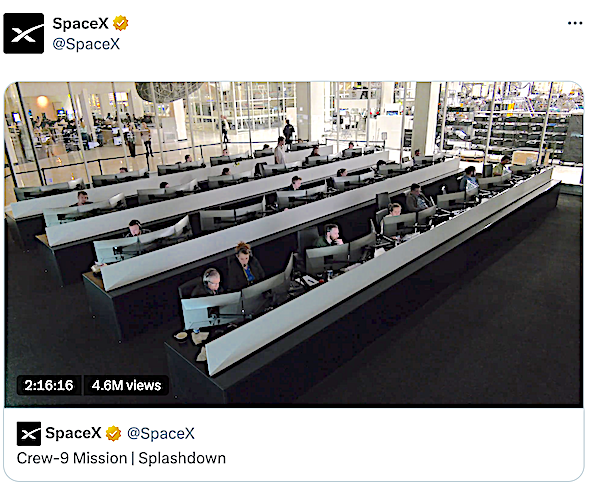
Williams and Wilmore smiled and waved at the camera, both providing thumbs-up as the crew wheeled them off for a medical check alongside their colleagues.
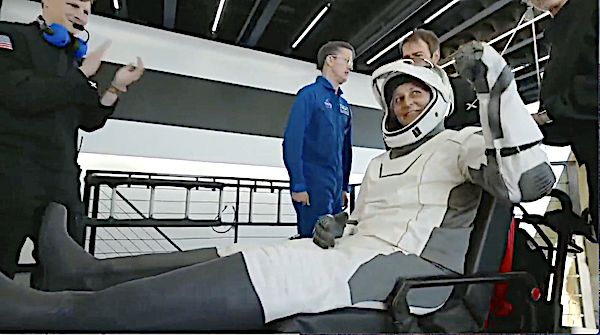
Falcon 9 launched Dragon and Crew-9 to the orbiting laboratory on Saturday, September 28 at 1:17 p.m. ET from Space Launch Complex 40 (SLC-40) at Cape Canaveral Space Force Station in Florida.
SpaceX sends NASA’s Crew-10 astronauts to ISS with two returning home after an unscheduled prolonged stay
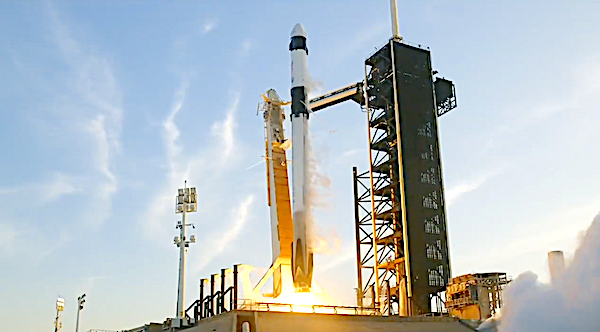
On Friday, March 14 at 7:03 p.m. ET, Falcon 9 launched Dragon’s tenth operational human spaceflight mission (Crew-10) to the International Space Station from Launch Complex 39A (LC-39A) at NASA’s Kennedy Space Center in Florida. Photos by Satnews.
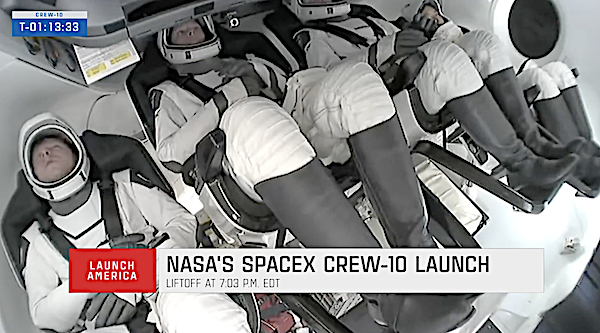
During their time on the orbiting laboratory, the crew will conduct new research to prepare for human exploration beyond low-Earth orbit and to benefit humanity on Earth.
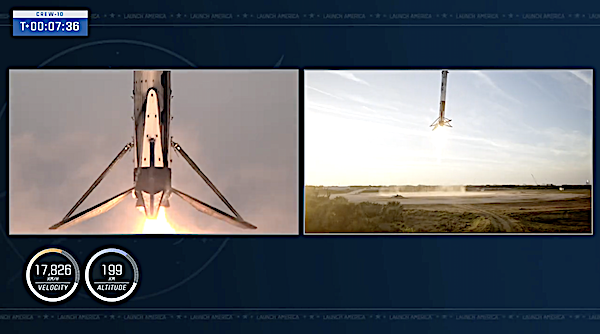
Following stage separation, Falcon 9’s first stage landed on Landing Zone 1 (LZ-1) at Cape Canaveral Space Force Station.
Dragon will autonomously dock with the space station on Saturday, March 15 at approximately 11:30 p.m. ET. Follow Dragon and the crew’s flight below.
They also aim to rescue Wilmore and Williams — who were only slated to be at the ISS for about a week in June before an issue emerged with Boeing’s Starliner spacecraft, which returned to Earth unmanned in September.
The live webcast of this mission will resume about one hour prior to docking, which you can watch here and on X @SpaceX. You can also watch the webcast on the new X TV app.
SpaceX scrubs Crew-10 human spaceflight mission due to transporter-erector hydraulics issue
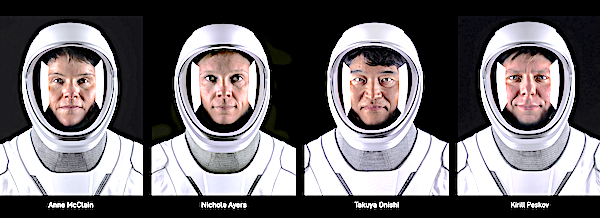
SpaceX and NASA are targeting no earlier than Friday, March 14 for Falcon 9’s launch of Dragon’s 10th operational human spaceflight mission (Crew-10) to the International Space Station from Launch Complex 39A (LC-39A) at NASA’s Kennedy Space Center in Florida. Launch is targeted for 7:03 p.m. ET, with a backup opportunity available on Saturday, March 15 at 6:41 p.m. ET. This new date is after an attempt to launch today was scrubbed due to a hydraulics issue with the transporter-erector, the structure that hauls the Falcon 9 to the pad and supports it once it’s there.
“Great working with you today,” Crew-10 commander Anne McClain of NASA told launch controllers after the scrub. “Kudos from the whole team, I know it was a lot of work to try to go, but like I said earlier, we’ll be ready when the equipment is.”
“This is a concern of basically just how the vehicle is held in place during release at liftoff,” said Mike Ravenscroft, launch vehicle office manager with NASA’s Commercial Crew Program.
There were no issues with Crew-10’s Falcon 9 or its Crew Dragon capsule, named Endurance.
SpaceX’s live webcast of this mission will begin about one hour and 20 minutes prior to liftoff, which you can watch on X @SpaceX. You can also watch the webcast on the new X TV app.
The Dragon spacecraft supporting this mission previously flew NASA’s Crew-3, Crew-5, and Crew-7 missions to and from the space station. This will be the second flight for the first stage booster supporting this mission, which previously launched the SES 03b mPOWER-e mission. Following stage separation, Falcon 9’s first stage will land on Landing Zone 1 (LZ-1) at Cape Canaveral Space Force Station.
During their time on the orbiting laboratory, the crew will conduct new research to prepare for human exploration beyond low-Earth orbit and to benefit humanity on Earth.
SpaceX and NASA’s Dragon on Crew-10 mission to send astronauts to ISS no earlier than Wednesday
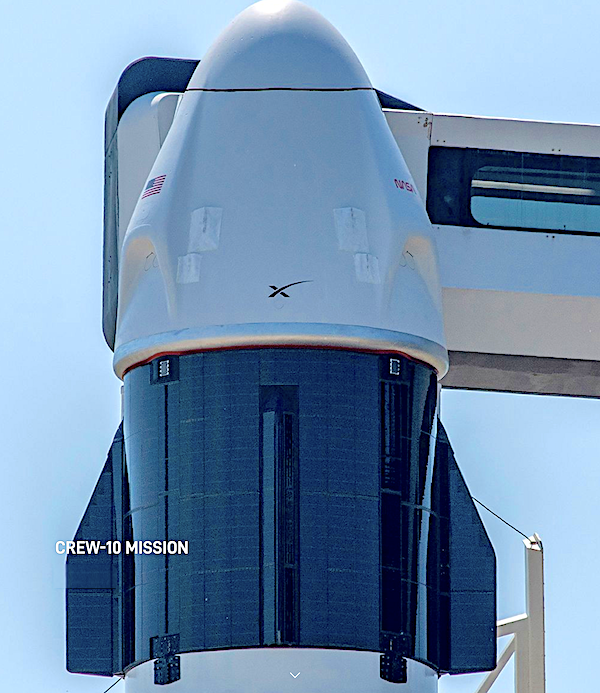
SpaceX and NASA are targeting no earlier than Wednesday, March 12 for Falcon 9’s launch of Dragon’s 10th operational human spaceflight mission (Crew-10) to the International Space Station from Launch Complex 39A (LC-39A) at NASA’s Kennedy Space Center in Florida. Launch is targeted for 7:48 p.m. ET, with a backup opportunity available on Thursday, March 13 at 7:26 p.m. ET.
SpaceX’s live webcast of this mission will begin about one hour and 20 minutes prior to liftoff, which you can watch on X @SpaceX. You can also watch the webcast on the new X TV app.
The Dragon spacecraft supporting this mission previously flew NASA’s Crew-3, Crew-5, and Crew-7 missions to and from the space station. Following stage separation, Falcon 9’s first stage will land on Landing Zone 1 (LZ-1) at Cape Canaveral Space Force Station.
During their time on the orbiting laboratory, the crew will conduct new research to prepare for human exploration beyond low-Earth orbit and to benefit humanity on Earth.
